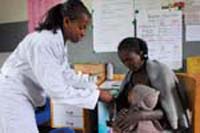8.1 The components and processes of communication
8.1.1 The source (sender)

The sender is the originator of the message. The source can be an individual or group, an institution or an organisation. People are exposed to communication from different sources, but are most likely to accept communication from a person or an organisation that they trust because they consider it to be a good source of reliable information (Figure 8.1).
Credibility can come from:
- A person’s natural position in the family or community — for example, head, village chief or elder.
- Through their personal qualities or actions — for example, a health worker who always comes out to help people, even at night.
- Respect for their qualifications and training.
- The extent to which the source of communication shares characteristics such as age, sex, education, religion or experiences with the receiver.
A person from a similar background to the members of the community is more likely to share the same language, ideas and motivations and thus be a more effective communicator.
One of the main reasons for communication failure is when the source comes from a different background from the receiver and uses inappropriate message content and appeals.
Look at Box 8.1. Why do you think that more overlap will make communication more effective? Give some reasons for your answer.
Box 8.1 Communication success and failure
Communication is likely to be successful if there is a high overlap with characteristics shared in common by the sender and the receiver.
If there is little overlap and many differences remain between source and receiver then communication is likely to be unsuccessful.
When the source comes from a similar background to the receiver he or she is more likely to share the same language, ideas and motivations and be able to communicate more effectively. This will increase the credibility of the message.
Look at Box 8.2 and tick all the items on the list which you have observed when people are communicating with each other. After you have done this think about which items are about including the listeners and which items you think are about being clear. As you do this remember that some items might do both.
Box 8.2 Effective communicators
An effective health communicator:
- Puts himself or herself both in the situation of the sender and the receiver
- Makes sure that they have the full attention of the other person
- Speaks in a loud and clear voice
- Formulates the message clearly in a way that can be easily understood
- Explains technical terms
- Is able to adapt the health messages to the educational background of the receiver
- Encourages the receiver to speak openly
- Gives full attention to the receiver
- Listens carefully
- Ensures that the message is understood
- Takes the questions and concerns of the receiver seriously
- Answers any questions fully.
You will probably have decided that many of the items in Box 7.2 are both about being inclusive and being clear. By being clear you are actually including more people. For example by answering questions fully you are being both clear and increasing the chances of more understanding on the part of those listening to you.
Learning Outcomes for Study Session 8
